Cumulative Interactions between the Global Blockage and Wake Effects as Observed by an Engineering Model and Large-Eddy Simulations
Abstract
:1. Introduction
2. Description of the Openwind Engineering Model Suite
2.1. Wake and Blockage Models
2.1.1. Deep Array Wake Model (DAWM)
- The EV and DAWM models are run for each wind turbine in turn, starting with the most upstream turbine, so that as each turbine’s wake is calculated, the incident wind speed, the minimum of that calculated using the DAWM and EV models for each upwind turbine, is already known and the appropriate value of the thrust coefficient can be used.
- If a blockage model is used, this is run with the values of used in the wake model, and the resulting wind speed deficits, blockage and wake, are combined as the linear superposition of both.
- There is an option to pre-run the blockage model before the wake model in order to modify the values used in the wake, but it has been found that this option does not add anything in terms of accuracy and so is not recommended.
2.1.2. Array-Stability Model (ASM)
- The wind speed ratio is calculated at each grid point and then is found downstream of each grid point N;
- The absolute minimum of is then calculated from which the value of at each turbine is used to estimate ;
- The TP (TurbOPark) wake model is run for each turbine using the freestream modified by the ASM;
- The minimum wind speed for the TP and farm models is taken as the modelled wind speed.
3. Case Study: The N-4 Offshore Wind Farm Cluster
4. Reference Dataset: Large-Eddy Simulations
5. Results
5.1. Large-Scale Flow Field
5.1.1. Large-Eddy Simulations (LES)
5.1.2. Deep-Array Wake Model (DAWM) Simulations
5.1.3. Array-Stability Wake Model (ASM) Simulations
5.2. Wind Farm Results
6. Discussion
7. Conclusions
Author Contributions
Funding
Data Availability Statement
Acknowledgments
Conflicts of Interest
Appendix A. Induction Model Performance in Openwind
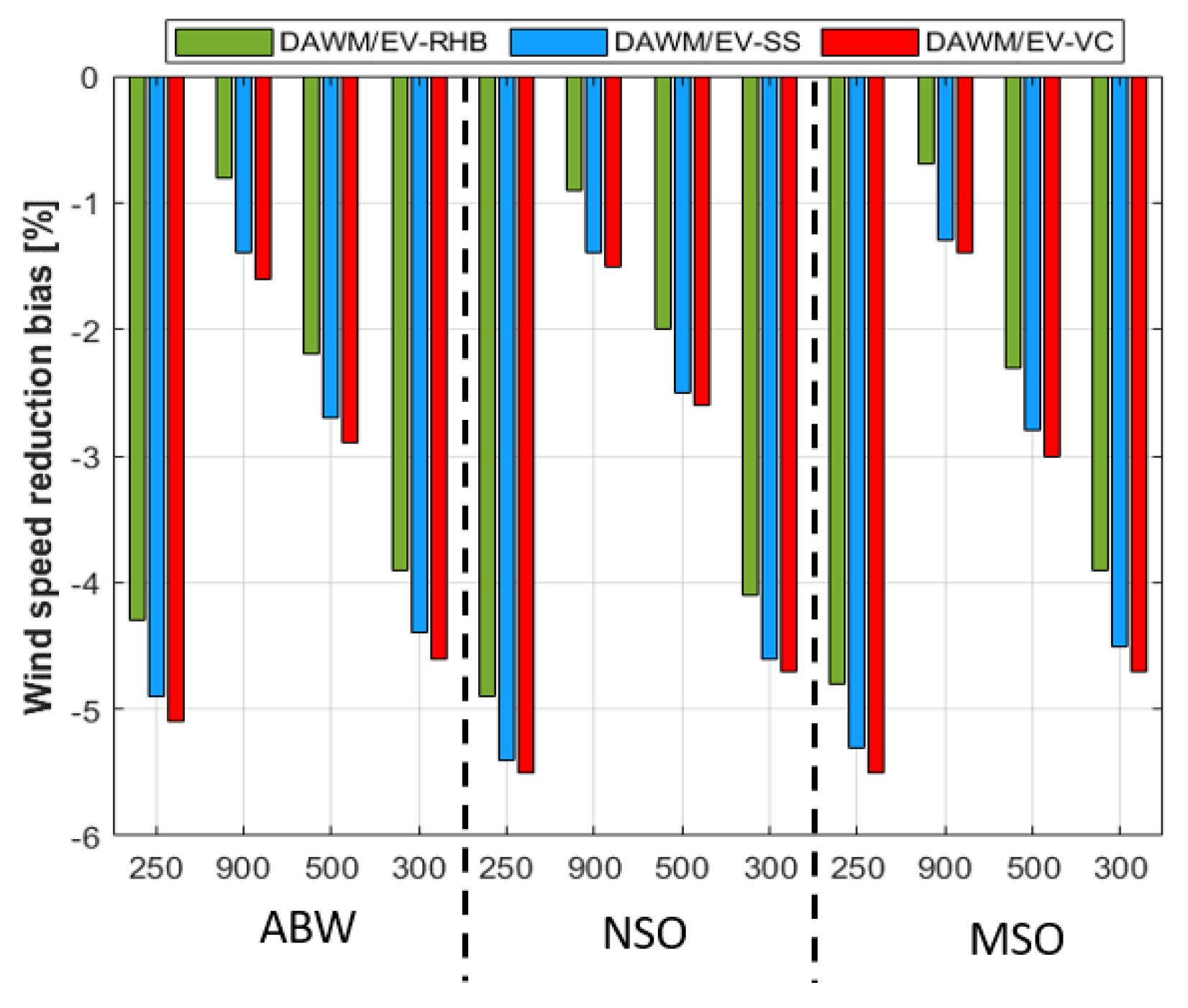
Appendix B. Array-Stability Model (ASM)
References
- Allaerts, D.; Meyers, J. Gravity Waves and Wind-Farm Efficiency in Neutral and Stable Conditions. Bound.-Layer Meteorol. 2018, 166, 990–1028. [Google Scholar] [CrossRef] [Green Version]
- Cañadillas, B.; Foreman, R.; Barth, V.; Siedersleben, S.; Lampert, A.; Platis, A.; Djath, B.; Schulz-Stellenfleth, J.; Bange, J.; Emeis, S.; et al. Offshore wind farm wake recovery: Airborne measurements and its representation in engineering models. Wind Energy 2020, 23, 1249–1265. [Google Scholar] [CrossRef]
- Platis, A.; Bange, J.; Bärfuss, K.; Cañadillas, B.; Hundhausen, M.; Djath, B.; Lampert, A.; Schulz-Stellenfleth, J.; Siedersleben, S.; Neumann, T.; et al. Long-range modifications of the wind field by offshore wind parks – results of the project WIPAFF. Meteorol. Z. 2020, 29, 355–376. [Google Scholar] [CrossRef]
- Nygaard, N.G.; Steen, S.T.; Poulsen, L.; Pedersen, J.G. Modelling cluster wakes and wind farm blockage. J. Phys. Conf. Ser. 2020, 1618, 062072. [Google Scholar] [CrossRef]
- UL-International. Openwind User Manual; Technical Report; AWS Truepower, LLC: Albany, NY, USA, 2020. [Google Scholar]
- Brower, M.; Robinson, N. The OpenWind Deep-Array Wake Model: Development and Validation; Technical Report; AWS Truepower: Albany, NY, USA, 2012. [Google Scholar]
- Frandsen, S.T. Turbulence and Turbulence-Generated Structural Loading in Wind Turbine Clusters; Risø National Laboratory: Roskilde, Denmark, 2007. [Google Scholar]
- Beaucage, P.; Robinson, N.; Brower, M.; Alonge, C. Overview of six commercial and research wake models for large offshore wind farms. In Proceedings of the EWEA 2012, Copenhagen, Denmark, 16–19 April 2012. [Google Scholar]
- Jensen, N. A Note on Wind Generator Interaction; Risø National Laboratory: Roskilde, Denmark, 1983. [Google Scholar]
- Ainslie, J. Calculating the flowfield in the wake of wind turbines. J. Wind. Eng. Ind. Aerodyn. 1988, 27, 213–224. [Google Scholar] [CrossRef]
- Bastankhah, M.; Porté-Agel, F. A new analytical model for wind-turbine wakes. Renew. Energy 2014, 70, 116–123. [Google Scholar] [CrossRef]
- Porté-Agel, F.; Bastankhah, M.; Shamsoddin, S. Wind-Turbine and Wind-Farm Flows: A Review. Bound.-Layer Meteorol. 2020, 174, 1–59. [Google Scholar] [CrossRef] [Green Version]
- Branlard, E.; Gaunaa, M. Cylindrical vortex wake model: Right cylinder. Wind Energy 2015, 18, 1973–1987. [Google Scholar] [CrossRef]
- Troldborg, N.; Meyer Forsting, A. A simple model of the wind turbine induction zone derived from numerical simulations. Wind Energy 2017, 20, 2011–2020. [Google Scholar] [CrossRef]
- Gribben, B.J.; Hawkes, G.S. A Potential Flow Model for Wind Turbine Induction and Wind Farm Blockage; Technical Report; Frazer-Nash Consultancy: Surrey, UK, 2019. [Google Scholar]
- Allaerts, D.; Meyers, J. Boundary-layer development and gravity waves in conventionally neutral wind farms. J. Fluid Mech. 2017, 814, 95–130. [Google Scholar] [CrossRef] [Green Version]
- Allaerts, D.; Meyers, J. Sensitivity and feedback of wind-farm-induced gravity waves. J. Fluid Mech. 2019, 862, 990–1028. [Google Scholar] [CrossRef]
- Lanzilao, L.; Meyers, J. Set-point optimization in wind farms to mitigate effects of flow blockage induced by atmospheric gravity waves. Wind. Energy Sci. 2021, 6, 247–271. [Google Scholar] [CrossRef]
- Bleeg, J.; Purcell, M.; Ruisi, R.; Traiger, E. Wind Farm Blockage and the Consequences of Neglecting Its Impact on Energy Production. Energies 2018, 11, 1609. [Google Scholar] [CrossRef] [Green Version]
- Emeis, S. Wind Energy Meteorology: Atmospheric Physics for Wind Power Generation; Springer: Berlin/Heidelberg, Germany, 2018. [Google Scholar]
- Maronga, B.; Gryschka, M.; Heinze, R.; Hoffmann, F.; Kanani-Sühring, F.; Keck, M.; Ketelsen, K.; Letzel, M.O.; Sühring, M.; Raasch, S. The Parallelized Large-Eddy Simulation Model (PALM) version 4.0 for atmospheric and oceanic flows: Model formulation, recent developments, and future perspectives. Geosci. Model Dev. 2015, 8, 2515–2551. [Google Scholar] [CrossRef] [Green Version]
- Maronga, B.; Banzhaf, S.; Burmeister, C.; Esch, T.; Forkel, R.; Fröhlich, D.; Fuka, V.; Gehrke, K.F.; Geletič, J.; Giersch, S.; et al. Overview of the PALM model system 6.0. Geosci. Model Dev. 2020, 13, 1335–1372. [Google Scholar] [CrossRef]
- Witha, B.; Steinfeld, G.; Dörenkämper, M.; Heinemann, D. Large-eddy simulation of multiple wakes in offshore wind farms. J. Phys. Conf. Ser. 2014, 555, 012108. [Google Scholar] [CrossRef] [Green Version]
- Steinfeld, G.; Witha, B.; Dörenkämper, M.; Gryschka, M. Hochauflösende Large-Eddy-Simulationen zur Untersuchung der Strömungsverhältnisse in Offshore-Windparks. Promet-Meteorol. Fortbild. 2016, 39, 163–180. [Google Scholar]
- Vollmer, L.; Steinfeld, G.; Heinemann, D.; Kühn, M. Estimating the wake deflection downstream of a wind turbine in different atmospheric stabilities: An LES study. Wind. Energy Sci. 2016, 1, 129–141. [Google Scholar] [CrossRef] [Green Version]
- Maas, O.; Raasch, S. Wake properties and power output of very large wind farms for different meteorological conditions and turbine spacings: A large-eddy simulation case study for the German Bight. Wind. Energy Sci. 2022, 7, 715–739. [Google Scholar] [CrossRef]
- Centurelli, G.; Vollmer, L.; Schmidt, J.; Dörenkämper, M.; Schröder, M.; Lukassen, L.; Peinke, J. Evaluating Global Blockage engineering parametrizations with LES. J. Phys. Conf. Ser. 2021, 1934, 012021. [Google Scholar] [CrossRef]
- Stieren, A.; Stevens, R.J.A.M. Evaluating wind farm wakes in large eddy simulations and engineering models. J. Phys. Conf. Ser. 2021, 1934, 012018. [Google Scholar] [CrossRef]
- Zhan, L.; Letizia, S.; Iungo, G. Optimal tuning of engineering wake models through lidar measurements. Wind. Energy Sci. 2020, 5, 1601–1622. [Google Scholar] [CrossRef]
- Grønnegaard Pedersen, J.; Svensson, E.; Poulsen, L.; Gayle Nygaard, N. Turbulence Optimized Park model with Gaussian wake profile. J. Phys. Conf. Ser. 2022, 2265, 022063. [Google Scholar] [CrossRef]
- Saiki, E.; Moeng, C.; Sullivan, P. Large-Eddy Simulation Of The Stably Stratified Planetary Boundary Layer. Bound.-Layer Meteorol. 2000, 95, 1–30. [Google Scholar] [CrossRef] [Green Version]
- Dai, Y.; Basu, S.; Maronga, B.; de Roode, S. Addressing the Grid-Size Sensitivity Issue in Large-Eddy Simulations of Stable Boundary Layers. Bound.-Layer Meteorol. 2020, 178, 63–89. [Google Scholar] [CrossRef]
- Wu, Y.T.; Porte-Agel, F. Large-Eddy Simulation of Wind-Turbine Wakes: Evaluation of Turbine Parametrisations. Bound.-Layer Meteorol. 2011, 138, 345–366. [Google Scholar] [CrossRef]
- Abkar, M. Impact of Subgrid-Scale Modeling in Actuator-Line Based Large-Eddy Simulation of Vertical-Axis Wind Turbine Wakes. Atmosphere 2018, 9, 257. [Google Scholar] [CrossRef] [Green Version]
- Asmuth, H.; Diaz, G.P.N.; Madsen, H.A.; Branlard, E.; Forsting, A.R.M.; Nilsson, K.; Jonkman, J.; Ivanell, S. Wind turbine response in waked inflow: A modelling benchmark against full-scale measurements. Renew. Energy 2022, 191, 868–887. [Google Scholar] [CrossRef]
- Dar, A.S.; Berg, J.; Troldborg, N.; Patton, E.G. On the self-similarity of wind turbine wakes in a complex terrain using large eddy simulation. Wind. Energy Sci. 2019, 4, 633–644. [Google Scholar] [CrossRef] [Green Version]
- Pena, A.; Mirocha, J.D.; van der Laan, M.P. Evaluation of the Fitch Wind-Farm Wake Parameterization with Large-Eddy Simulations of Wakes Using the Weather Research and Forecasting Model. Mon. Weather. Rev. 2022, 150, 3051–3064. [Google Scholar] [CrossRef]
- Williamson, J. Low-storage runge-kutta schemes. J. Comput. Phys. 1980, 35, 48–56. [Google Scholar] [CrossRef]
- Magnusson, M.; Smedman, A.S. Air flow behind wind turbines. J. Wind. Eng. Ind. Aerodyn. 1999, 80, 169–189. [Google Scholar] [CrossRef]
- Strickland, J. Modeling Wakes and Blockage in Large-Scale Wind Farms. Ph.D. Thesis, University of Twente, Enschede, The Netherlands, 2021. [Google Scholar] [CrossRef]
- Platis, A.; Siedersleben, S.; Bange, J.; Lampert, A.; Bärfuss, K.; Hankers, R.; Cañadillas, B.; Foreman, R.; Schulz-Stellenfleth, J.; Djath, B.; et al. First in situ evidence of wakes in the far field behind offshore wind farms. Sci. Rep. 2018, 8, 2163. [Google Scholar] [CrossRef] [PubMed] [Green Version]
- Medici, D.; Ivanell, S.; Dahlberg, J.; Alfredsson, P.H. The upstream flow of a wind turbine: Blockage effect. Wind Energy 2011, 14, 691–697. [Google Scholar] [CrossRef]
- Emeis, S. A simple analytical wind park model considering atmospheric stability. Wind Energy 2010, 13, 459–469. [Google Scholar] [CrossRef]
- Frandsen, S. On the wind speed reduction in the center of large clusters of wind turbines. J. Wind. Eng. Ind. Aerodyn. 1992, 39, 251–265. [Google Scholar] [CrossRef]


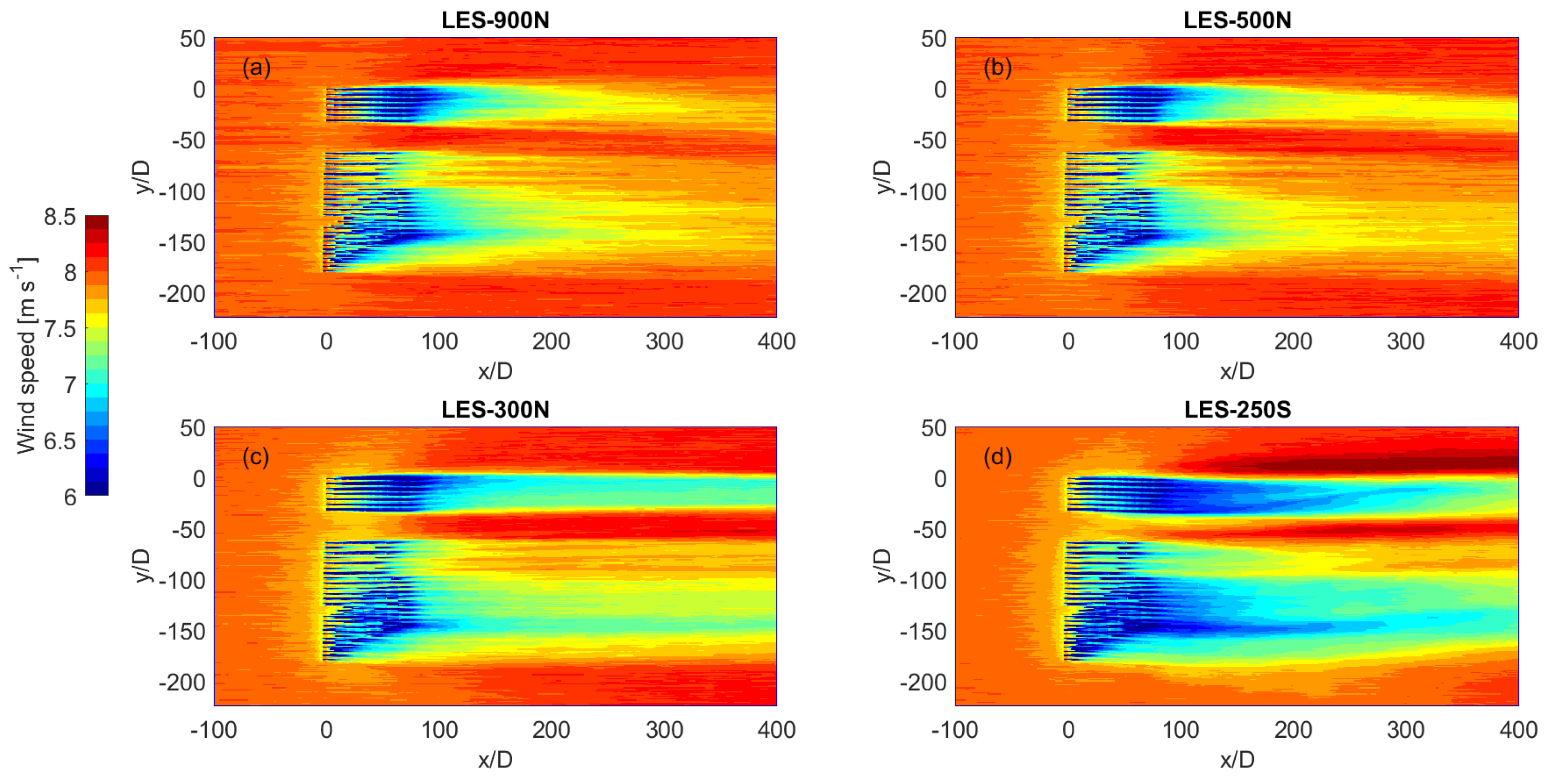

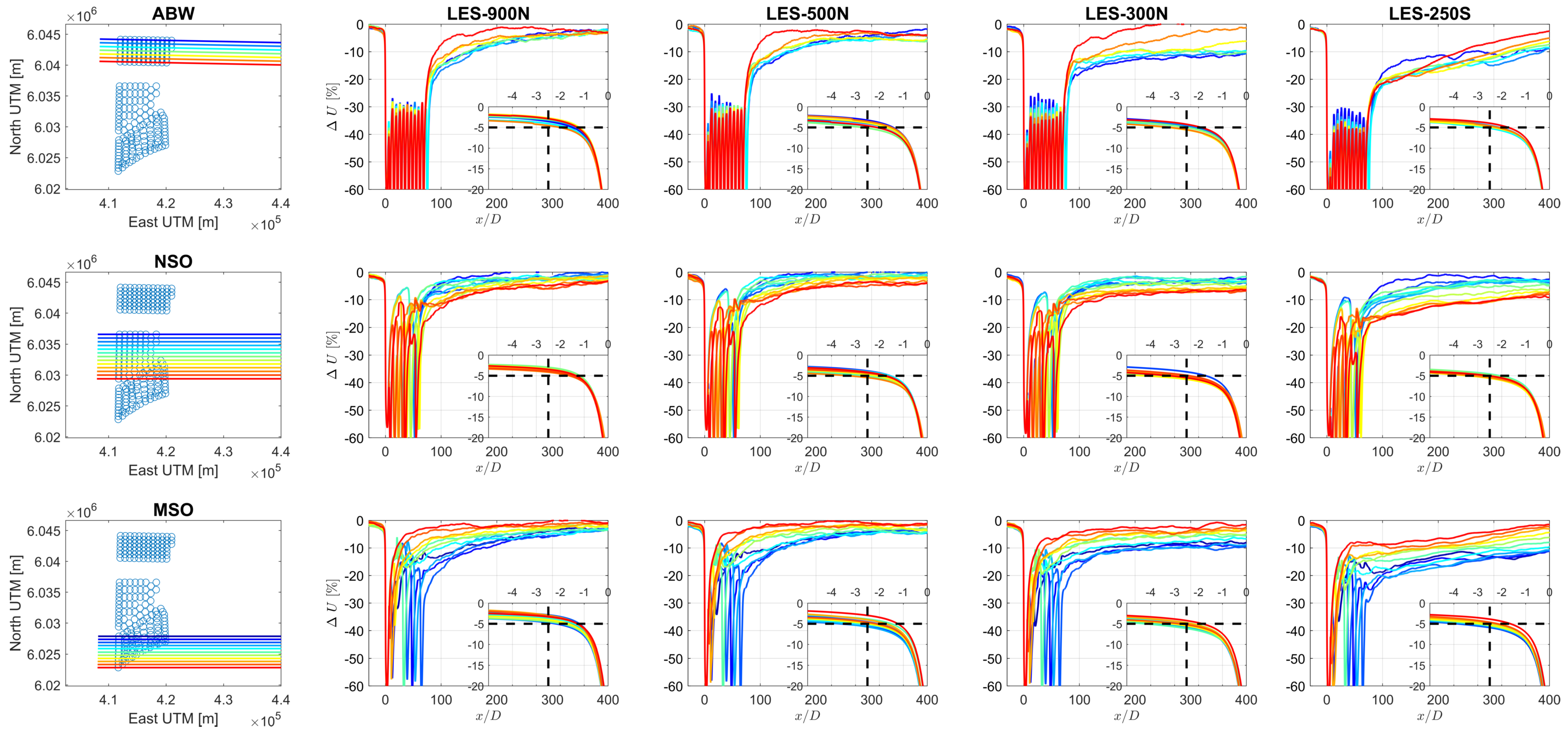

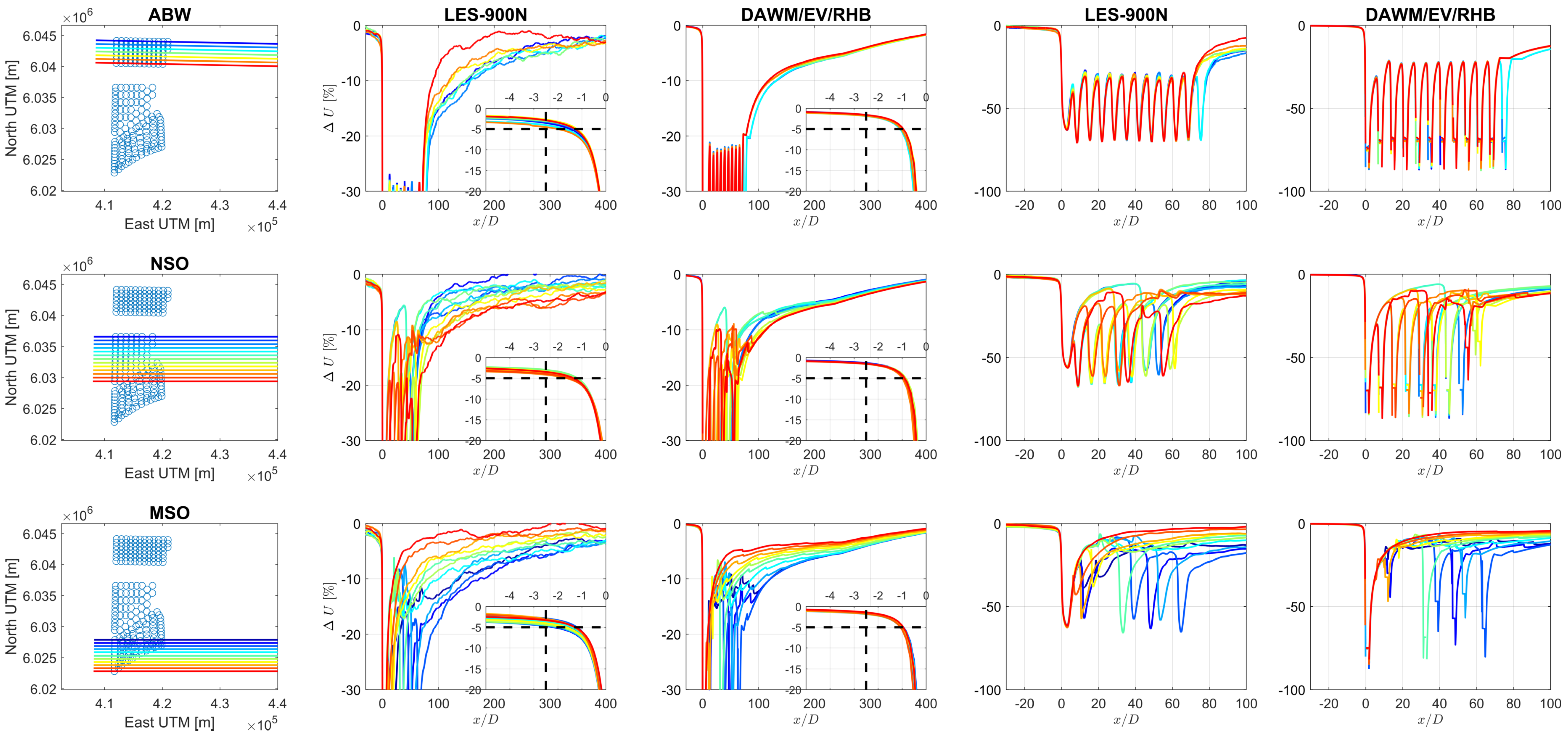

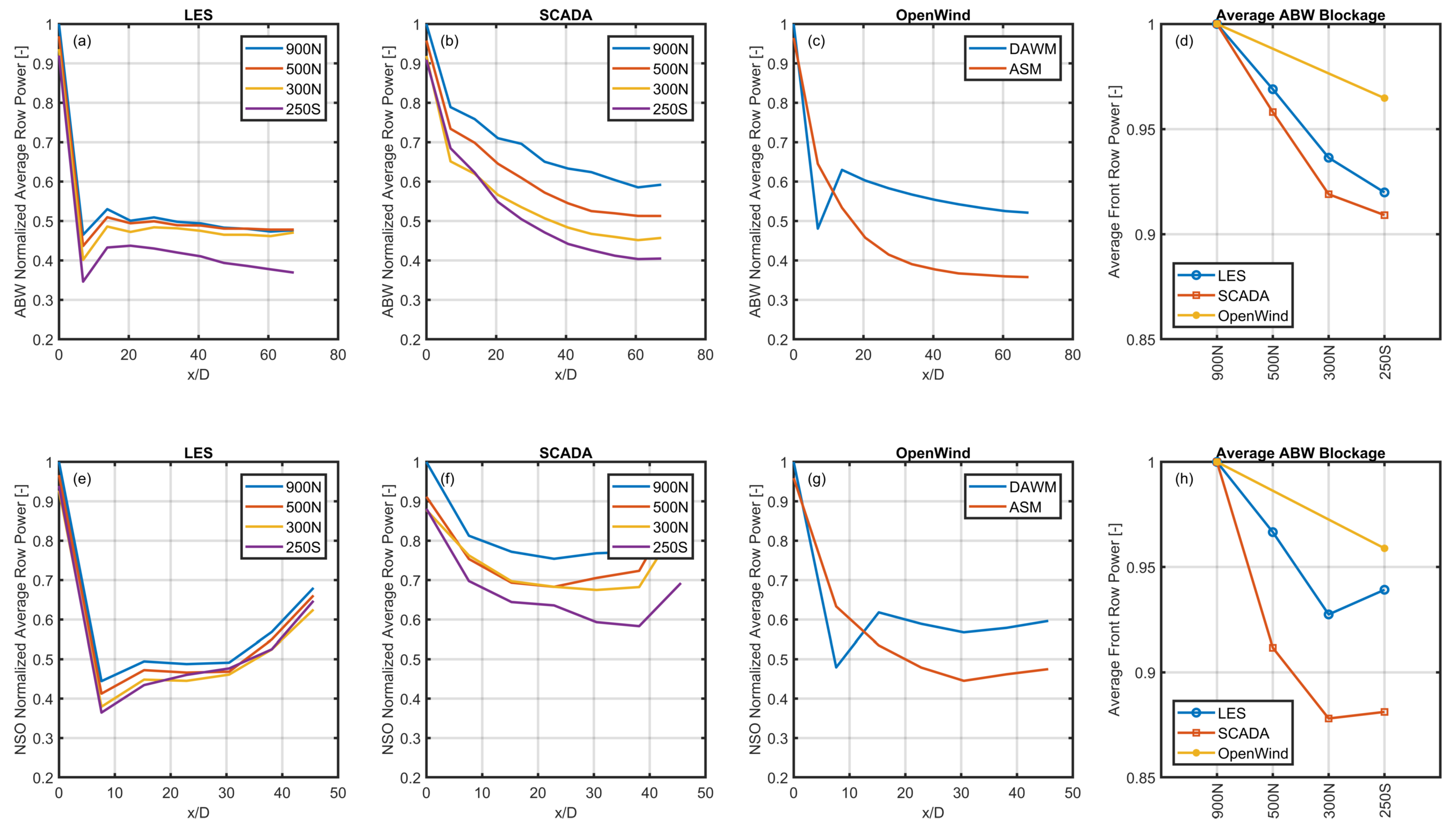
| Model ID: | DAWM-RHB [6] | ASM [20] |
|---|---|---|
| Turbine wake model | EV [10] | TP |
| Induction model | RHB | N/A |
| Roughness length [m] | 0.001 | 0.0002 |
| Wind speed [m s] | 8 | 8 |
| Wind direction [°] | 270 | 270 |
| Ambient turbulence intensity [%] | 4.5 | 4.5 |
| Stability | N/A | , 250 m |
| ID | Wind Farm | Turbine Type | [m] | No. WTs | [-] |
|---|---|---|---|---|---|
| ABW | Amrumbank West | Siemens SWT-3.6MW | 120/90 | 80 | 5–7 |
| NSO | Nordsee Ost | Senvion 6.2MW | 126/95 | 48 | 5–10 |
| MSO | Meerwind Süd|Ost | Siemens SWT-3.6MW | 120/89 | 80 | 4–12 |
| ID | ABL | No Grid Points | Top Model | Grid Resolution | ABL | [m s]/ |
|---|---|---|---|---|---|---|
| Stability | Domain [m] | (x = y = z) | Height [m] | [] | ||
| LES-300N | Neutral | 8192 × 12,288 × 256 | 10,340 | 10 stretched above 495 m | 320 | 8/270 |
| LES-500N | Neutral | 8192 × 12,288 × 256 | 10,690 | 10 stretched above 795 m | 530 | 8/270 |
| LES-900N | Neutral | 8192 × 12,288 × 256 | 10,940 | 10 stretched above 1195 m | 840 | 8/270 |
| LES-250S | Stable | 10,240 × 16,384 × 64 | 10,340 | 10 stretched above 495 m | 250 | 8/270 |
| ABW WF | NSO WF | |
|---|---|---|
| PBL-900 | [20 40] | [42 136] |
| PBL-500 | [24 62] | [29 133] |
| PBL-300 | [38 62] | [60 206] |
| PBL-200S | [57 92] | [91 207] |
Disclaimer/Publisher’s Note: The statements, opinions and data contained in all publications are solely those of the individual author(s) and contributor(s) and not of MDPI and/or the editor(s). MDPI and/or the editor(s) disclaim responsibility for any injury to people or property resulting from any ideas, methods, instructions or products referred to in the content. |
© 2023 by the authors. Licensee MDPI, Basel, Switzerland. This article is an open access article distributed under the terms and conditions of the Creative Commons Attribution (CC BY) license (https://creativecommons.org/licenses/by/4.0/).
Share and Cite
Cañadillas, B.; Foreman, R.; Steinfeld, G.; Robinson, N. Cumulative Interactions between the Global Blockage and Wake Effects as Observed by an Engineering Model and Large-Eddy Simulations. Energies 2023, 16, 2949. https://doi.org/10.3390/en16072949
Cañadillas B, Foreman R, Steinfeld G, Robinson N. Cumulative Interactions between the Global Blockage and Wake Effects as Observed by an Engineering Model and Large-Eddy Simulations. Energies. 2023; 16(7):2949. https://doi.org/10.3390/en16072949
Chicago/Turabian StyleCañadillas, Beatriz, Richard Foreman, Gerald Steinfeld, and Nick Robinson. 2023. "Cumulative Interactions between the Global Blockage and Wake Effects as Observed by an Engineering Model and Large-Eddy Simulations" Energies 16, no. 7: 2949. https://doi.org/10.3390/en16072949





